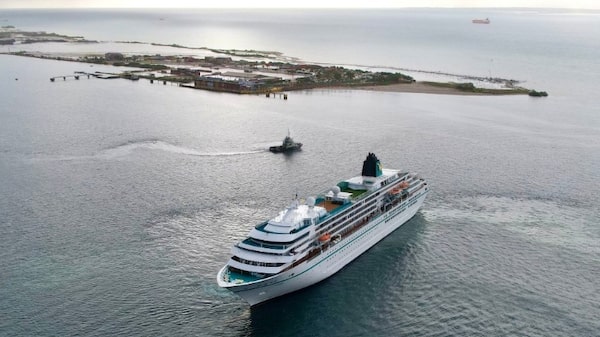Bloomberg — A submersible carrying five people to tour the wreck of the Titanic on the Atlantic seabed went missing on Sunday. The dive craft’s command ship lost contact with the submersible and its occupants less than two hours after launch, after which it informed the US Coast Guard.
Extensive rescue operations are currently underway, with the craft’s air supply thought to last a little under three more days. Here’s what we know about the missing vessel, the company behind the tours, and its Chief Executive Officer Stockton Rush, who is believed to be on board:
What is the Titan submersible?
The missing craft is owned by OceanGate and is named Titan. The sub is designed to carry five people — a pilot and four passengers — and is made of carbon fiber and titanium, according to OceanGate’s website. It measures 6.7 meters in length and is designed to reach depths of 2.5 miles (4 kilometers). The Titanic sits on the seabed 2.4 miles down.
What is it like on board?
It’s cramped and there are few facilities. Travelers are sealed into the cylindrical capsule from the outside. Inside the air is breathable and is recycled in a similar way to a spacecraft, and internal pressure remains constant. Facilities are sparse. At one end is a viewing portal 21 inches in diameter, which allows two passengers to look outside at once. There is a very small bathroom on board.
What happened to the Titan?
Right now, nobody knows. According to the US Coast Guard, about an hour and 45 minutes after the sub launched on Sunday, the submersible’s command ship, the Polar Prince, lost contact with the vessel about 900 miles (1,450 kilometers) east of Cape Cod, Massachusetts.
How much air does the Titan have left?
Authorities said the sub is able to provide occupants with about 96 hours of air in an emergency, citing information from the company. The US Coast Guard estimated on Tuesday afternoon that the vessel would likely run out of air early Thursday morning.
How is the Titan launched?
The craft sits on a platform until it reaches about 30 feet below the water’s surface, where it can start its journey to the seabed without the turbulence of waves and currents. Upon its return, it docks with the platform and ballast tanks are filled with air, bringing the craft and its passengers back to the surface.
How is the submersible controlled?
The sub can travel at a speed of three knots and descend at 55 meters per minute, with propulsion coming from four electric thrusters. Attached equipment includes powerful external lights, cameras and a laser scanner. David Pogue, a CBS journalist who took a trip in the Titan to view the Titanic in 2022, said he was surprised to discover the craft was controlled with a video game controller.
Who built the sub?
The Titan was built by Washington-based private company OceanGate Expeditions, which runs underwater vessels for charter and scientific exploration. It was the brainchild of CEO Stockton Rush, who, the company confirmed, is on board. Rush, who holds a degree in aerospace engineering from Princeton University and an MBA from UC Berkeley’s Haas School of Business, worked with NASA and Boeing on the craft’s design.
What does OceanGate offer tourists hoping to see the Titanic?
OceanGate charges at least $250,000 for expeditions to the Titanic shipwreck. According to its website, the expedition lasts over a week and sets off from the Canadian city of St. John’s in Newfoundland. Single dives take six to eight hours to reach the Titanic site, explore, and return to the surface.
What are difficulties with a potential rescue?
If the sub has sunk near the Titanic wreck, the depth of the site complicates any rescue efforts because few other vessels, including those designed for Navy submarine rescue, are able to go so deep, let alone retrieve a submersible from the seabed, according to Alistair Greig, a professor of marine engineering at University College London. If the Titan has risen to the surface, it could be bobbing about waiting to be found, a highly uncomfortable situation for the occupants because subs aren’t designed to be on the surface, Greig added.
Read more on Bloomberg.com


